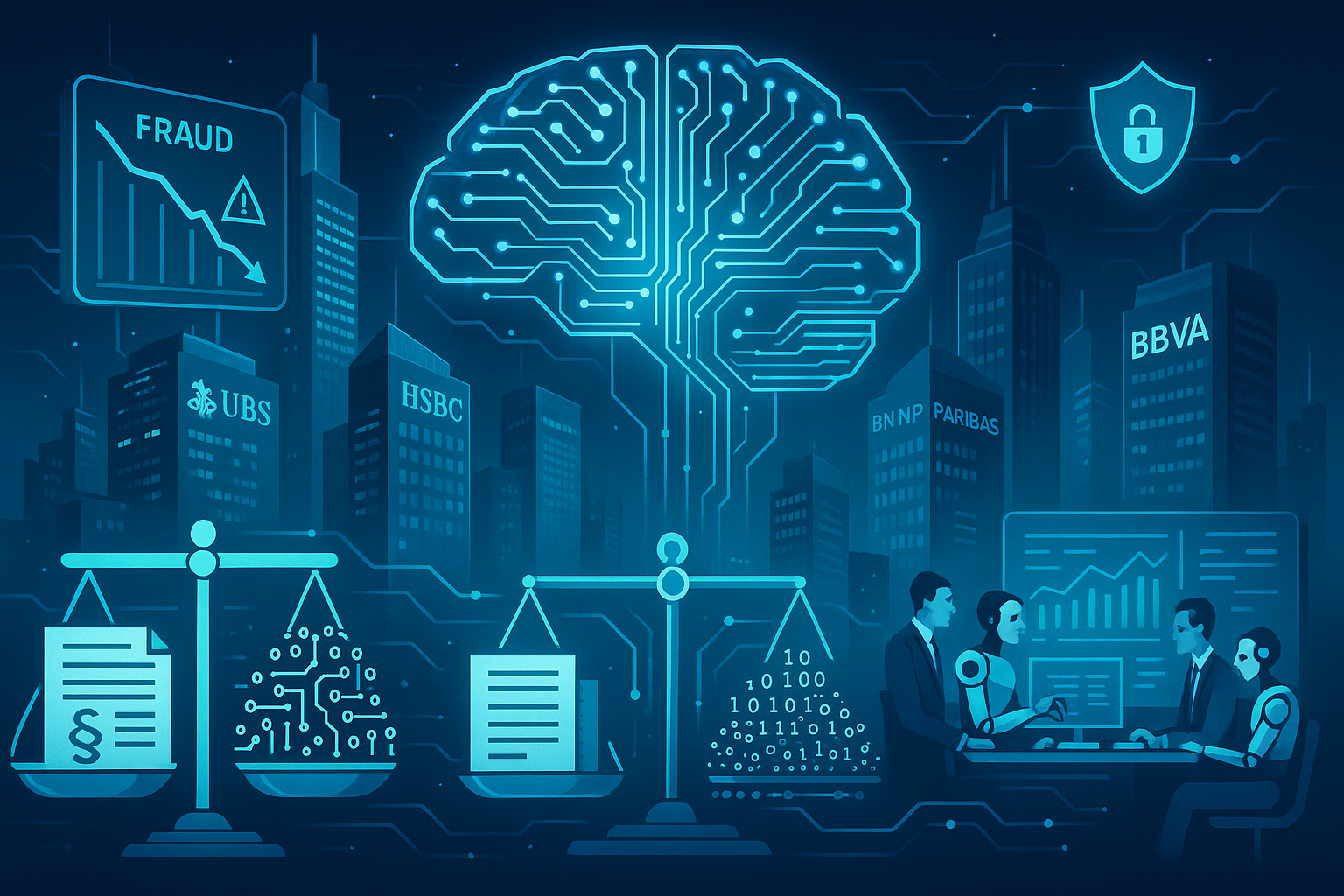· 4 min read
AI in Finance: The Real Competitive Leap Begins in 2025
Artificial intelligence is transforming the financial sector, with its global market expected to grow by 350% by 2032, driven by fraud prevention, process automation, and regulatory compliance. European banks such as UBS, HSBC, and BBVA are leading this innovation, adopting AI to enhance efficiency and security. As its use expands, regulatory frameworks like the European AI Act and the Algorithmic Transparency Law aim to ensure transparency, accountability, and protection against bias.

Artificial intelligence (AI) has become a key catalyst for change in the financial sector. According to Funds Society, the global AI market in finance will reach $39 billion by 2032, representing a 350% increase compared to 2023. Banks and financial institutions worldwide are accelerating AI adoption to prevent fraud, automate processes, ensure regulatory compliance, and improve operational efficiency.
In fact, European banks are among the global leaders in AI adoption, with institutions such as UBS, HSBC, BNP Paribas, and BBVA ranking at the top of international AI innovation indexes.
Below, we explore emerging trends in the sector—from fraud prevention to operational efficiency—and how they are framed within an increasingly demanding regulatory context, including initiatives like the European AI Act and Spain’s Algorithmic Transparency Law.
Fraud Prevention with AI
Combating financial fraud has been one of the first and most prominent areas of AI application in banking. Machine learning systems analyze massive volumes of transactions in real time to identify anomalous patterns that may indicate fraudulent activity. This allows for faster and more accurate fraud detection than traditional methods.
According to El Economista, the adoption of AI has enabled companies to reduce fraud attempts in electronic transactions by up to 86%. In some cases, up to 35% of companies were able to eliminate fraud entirely thanks to these suspicious behavior analysis techniques.
A strong example of AI’s impact comes from Visa, whose AI system prevented $40 billion worth of fraudulent transactions globally in 2023.
AI not only blocks known threats—it also learns from new patterns to anticipate emerging fraud tactics. Advanced payment platforms can now recognize the buyer in 90% of cases through data analysis, even if it’s the first time the user interacts with a merchant.
Thanks to these capabilities, banks and payment processors are minimizing fraud losses while also reducing “false positives.” AI helps filter these alerts, allowing risk analysts to focus on truly critical cases.
Automation of Financial Processes
Another transformative trend is the intelligent automation of processes. Many institutions began applying AI to administrative and back-office tasks, where its impact is most evident.
For example:
- Automating repetitive tasks such as document processing and account reconciliation
- Using computer vision algorithms to read and verify financial documents
- Reducing customer onboarding costs by up to 40%
- Eliminating manual data reconciliation and review tasks
This allows human teams to focus on higher-value activities such as strategic analysis or personalized customer service.
Regulatory Compliance with Artificial Intelligence
Regulatory compliance and risk management are areas where AI is delivering significant benefits.
Traditionally, software systems generated between 90% and 95% false positives. AI enables:
- Discovery of hidden patterns in transactions
- Comparison of individual behaviors with risk profiles
- Reduction of irrelevant alerts by up to 65%
- Retention of at least 99% of truly suspicious cases
Additionally:
- Regulatory reports can be generated up to 5 times faster
- Improved quality and consistency of reported data
- Cost reductions without sacrificing quality or security
Operational Efficiency and Competitiveness
AI aims to enhance the operational efficiency and competitiveness of financial institutions. In a context of tight margins, this is essential.
Example: CaixaBank plans to invest €5 billion between 2025 and 2027, with AI as a key driver.
Reported results:
- 40% reduction in customer onboarding costs
- Up to 50% decrease in compliance incidents
- Reports generated up to 5 times faster
These advancements improve:
- Cost-to-income ratios
- Customer experience
- Accuracy of banking services
An exponential increase is projected in investment in generative AI, focused on:
- Chatbots
- Automated risk assessment
- Real-time fraud detection
- Mass document processing
Regulatory Frameworks: From the European AI Act to Algorithmic Transparency
The rapid adoption of AI in finance has led to increased regulatory scrutiny.
At the European level:
- AI Act: a world-leading regulatory framework
- Covers “high-risk” applications such as credit scoring
- Requires: data quality, traceability, risk management, and human oversight
In Spain:
- The Artificial Intelligence Supervisory Agency and regulatory sandbox are already in place
- The proposed Algorithmic Transparency Law aims to ensure:
- The right to explanation
- Auditability of automated decisions
Financial regulators (such as the BIS or Basel Committee) emphasize:
- Human control over automated decisions
- Ethical oversight in fraud detection and lending
- Prevention of bias affecting vulnerable groups
Regulatory mantra: Innovation in AI is welcome—as long as it respects transparency, accountability, and current regulations.
ALS Innovation and the Practical Application of AI
ALS Innovation has extensive experience in developing and integrating AI solutions for the financial sector.
We combine:
- Expertise in data analytics
- Knowledge of regulatory frameworks
- Banking operations experience
We support institutions in adopting technologies that enhance efficiency, security, and compliance—adapting to the sector’s current challenges.
Sources
- Industry reports and articles on AI in finance published by Funds Society, El Economista, and Oracle (2024)
- Data and regulations from the Bank of Spain and the European Union (Artificial Intelligence Act, Algorithmic Transparency Law)

